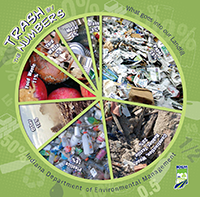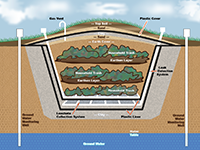Overview
Ready to get students excited about solid waste, also known as garbage or trash. The Indiana Department of Environmental Management (IDEM) has developed an eLearning lesson plan to assist in teaching students about trash, where it goes, and how they can create less trash.
For the purpose of this lesson we will only be discussing municipal solid waste (MSW) landfills. MSW landfills receive household trash.
Objective
Students will:
- learn trash is commonly referred to as solid waste
- perform a waste audit
- explore ways to create less trash
Background Information
What is Solid Waste?
Everyone produces solid waste, otherwise known as trash or garbage. Trash can be old newspapers, potato chip bags, disposable diapers, shampoo bottles, dental floss, grass clippings, food scraps, even electronics. Each person in the United States generates 4.6 pounds of trash each day.
As our population grows, so has the number of products we use and the total amount of trash we generate. The composition of trash continues to change as our shopping habits change.
How do we manage trash?
No single method can manage all our nation’s trash. The U.S. Environmental Protection Agency (U.S. EPA) recommends a waste management hierarchy, which ranks methods of waste management in order of preference.
- Source Reduction:
- This method prevents waste at the source by decreasing consumption and reusing products.
- Recycling and Composting:
- Recycling is a series of activities where discarded materials are collected, sorted, processed, converted into raw materials, and used to make new products.
- Composting is the decomposition of organic materials such as yard trimmings and food scraps by microorganisms. The decomposed product of this process is called compost.
- Disposal:
- Trash that cannot be reduced, recycled, or composted. There are two disposal options in Indiana, (1) Incineration, and (2) Landfill. Both are subject to environmental controls that require them to be properly maintained so waste does not contaminate our land, air, or water.
- Incineration:
- is the burning of trash in a specially designed facility, and reduces the amount of trash. Indiana has one municipal solid waste Incinerator for trash.
- Landfill:
- a large area of land that is engineered to receive waste and is a major component of managing trash.
For Where Trash Goes we are focusing on landfills. A landfill’s basic function is to isolate buried trash from the surrounding environment. Landfills use a series of layers and barriers to keep trash in its place. The Indiana Department of Environmental Management (IDEM) is the state agency that regulates landfills in Indiana. There are 34 municipal solid waste landfills in Indiana that accept household trash. To protect the environment landfills have the following layers and barriers:
- Clay Soil: Used as a bottom and top layer during landfill construction. Forms a barrier between the trash and the environment.
- Liner: A thick plastic layer on the top and bottom of a landfill. It keeps leachate and methane gas within the landfill. Protects groundwater and the environment.
- Leachate: Any liquid oozing through the landfill. It can be liquids present in the trash or from precipitation such as rain, snow, or sleet.
- Trash: Everyday items discarded by households, businesses, and organizations. Trash is also referred to as garbage or solid waste.
- Methane Gas Pipes: Decomposing trash produces methane gas. Pipes throughout the landfill vent the methane to the surface of a landfill.
- Groundwater Monitoring Well: Used to monitor groundwater for contamination.
- Closed Landfill: A landfill no longer accepting trash.
- Topsoil: Soil added on top of the clay cap. It supports the growth of vegetation.
- Landscaping: After a landfill is closed, native grasses will be planted in the top soil. The plants will help keep top soil from eroding.
What are the Benefits of Waste Management?
At one time people dumped trash out windows, burned it in fields, and even left it in open dumps. Open dumps attract pests, smell, and pollute drinking water supplies.
Federal, state, and local laws now control how trash is managed and disposed. These laws, or regulations, set standards for trash disposal and protect land, air, and water.
Activities
Where Trash Goes has flexible activities, where you can use sections of the lesson or extend sections. The hands-on home activity will not require students to purchase any supplies.
Where Trash Goes, Student Page Activities
Have students read Where Trash Goes: Student Page and complete the following worksheets:
- Where Trash Goes Student Question Page (Answer Key)
- Where Trash Goes Crossword Puzzle [PDF]
- Where Trash Goes Word Search [PDF]
- Solid Waste Landfill Diagram [PDF]
Where Trash Goes: Trash Journal Activity
Objective: To increase students’ awareness of the amount of trash they generate.
Activity Description: Students will keep a journal of their family’s trash for five days.
Materials Needed: Trash bag, copy of My Trash Journal. Instructions for students are listed on the My Trash Journal worksheet.
Questions:
- What are natural resources?
- What is one renewable natural resource?
- What is one nonrenewable natural resource?
- What will happen if we keep using more and more natural resources?
- How can we stop using so many natural resources?
Where Trash Goes: Landfill Video
Have students review landfill video and answer questions.
Writing Activity
Have students pick a natural resource and describe why it is special, or why they like the natural resource they picked.
Have students write about their favorite toy or electronic device. Have them write a history of where their item came from, including the resources used in producing it and packaging it came in, and how it came into their house. Have them describe what they will do with it when it is broken, old, or no longer needed.
Home Scavenger Hunt
Activity Description: Make a list of common items found inside or outside your home that are made from animals, plants, metals, minerals, fossil fuels, or sand. Find 15 to 30 items and identify the category they belong in.
Materials Needed: Piece of paper, writing utensil
Additional Activities
- Indiana Solid Waste Landfills Trivia Map [PDF] Download the PDF file and open it in Adobe Acrobat. (The file will not work in your browser PDF plug-in.)


